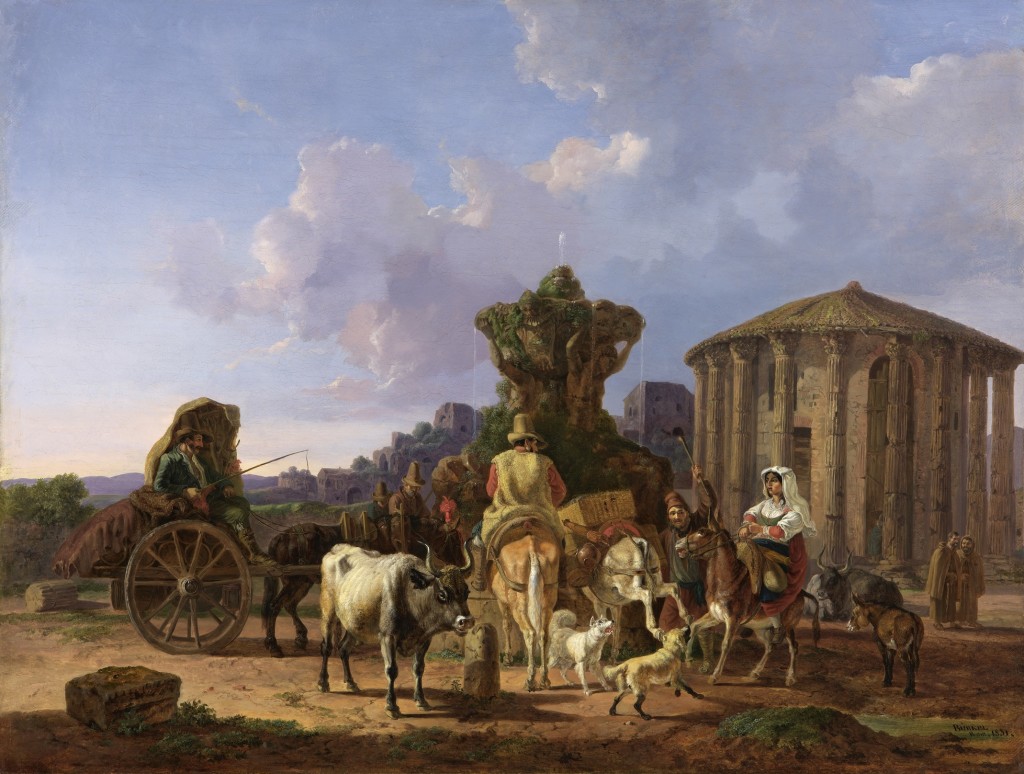Heinrich Bürkel (Pirmasens 1802 - 1869 Munich)
Peasants in front of the Temple of Vesta, 1831
Oil on canvas, mounted on panel, 57.5 x 75.5 cm
Signed, inscribed and dated lower right BÜRKEL Rom. 1831
Provenance:
Georg Schäfer collection, Schweinfurt
Private collection
Exhibited:
Heinrich Bürkel zum 100. Todestag. Gemälde und Graphik, exhib. cat., Kaiserslautern, Pfalzgalerie, 14.6.-3.8.1969, no. 29
Literature:
Luigi von Buerkel, Heinrich Bürkel, Munich 1940, no. 81
Hans-Peter Bühler and Albrecht Krückl, Heinrich Bürkel. Mit Werkverzeichnis der Gemälde, Munich 1989, p. 290, fig. 556 and plate 25
Born in Pirmasens, Germany, in 1802, Heinrich Bürkel moved to Munich in 1822. Distancing himself from academic teaching, he educated himself by copying Dutch Old Masters in the Royal Collection. In 1825 he joined the newly-established Münchner Kunstverein which had been set up as a counterweight to the Academy.
Bürkel travelled widely in Upper Bavaria and the Tyrol, first visiting Italy in 1827. He executed the present painting in 1831 on his second journey to Italy. He worked in Rome from 1830 to 1832 and returned to Italy for the last time in 1853/54. He died in Munich in 1869 after a long illness.[1]
In the spring of 1831 – some nine months after his arrival in Rome – he showed four works at an international exhibition on the Capitoline Hill organized by the association of German artists in Rome. All four works depicted Italian motifs and the present painting is one of them. Bertel Thorvaldsen, impressed by Bürkel’s abilities, purchased two of the paintings, now at the Thorvaldsen Museum in Copenhagen (Cat. Rais. 554 und 579)[2].
The painting portrays an everyday scene on the Piazza Bocca della Verità in the Forum Boarium in Rome. Oxen and donkeys are being herded towards the Triton Fountain, a fountain flanked by a temple. Designed by Carlo Bizzacheri (1655-1712), and built around 1716, the fountain was commissioned by Pope Clement XI. The temple’s true name – the Temple of Hercules Victor – is rarely used even today. It is incorrectly known as the Temple of Vesta because its circular, pillar-lined corpus recalls the ruins of the Temple of Vesta at the Forum Romanum.
The painting’s background with its precise depiction of the topography of Rome shows Bürkel’s mastery as a landscape painter and his skill in rendering the metallic heat and glare of a searing summer day in Rome. The foreground reflects his love of genre and preference for anecdotal subject matter. A donkey rears up, startled by a pack of yapping dogs. The viewer is drawn into the scene, and left to muse on what topic of discussion so engrosses the two monks.
[1] See Hans-Peter Bühler and Albrecht Krückl, Heinrich Bürkel. Mit Werkverzeichnis der Gemälde, Munich 1989. [2] See Bühler, op. cit., p. 290 and 293.

